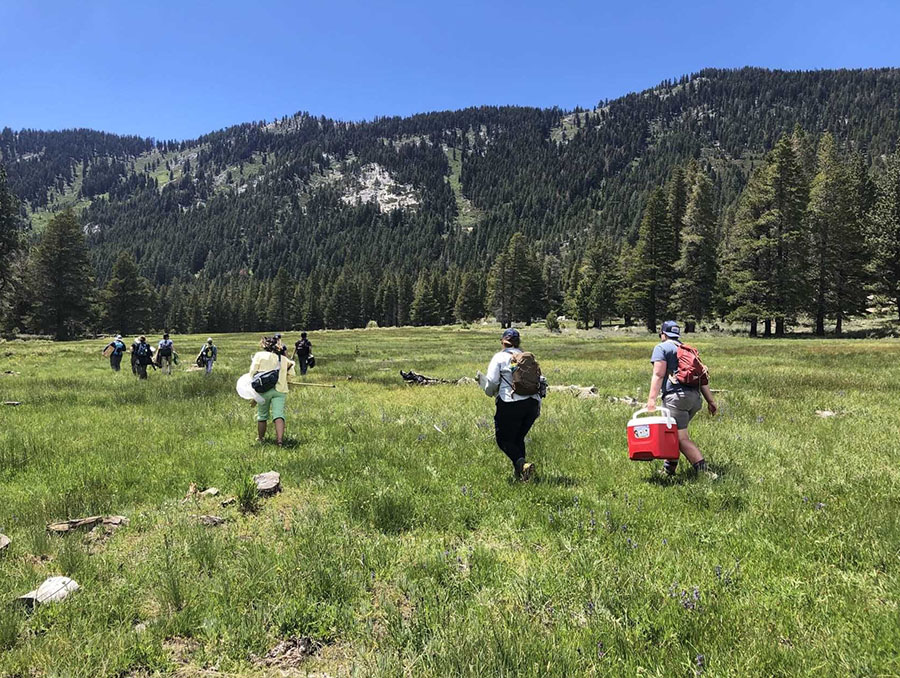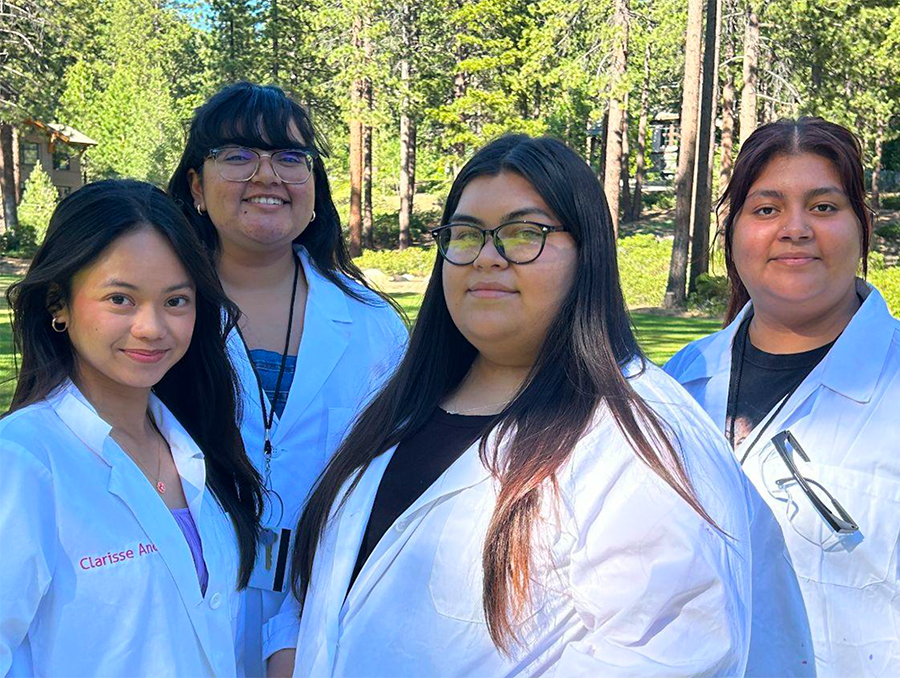Biology 322, Experimental Field Ecology, returned to the University of Nevada, Reno’s Whittell Forest & Wildlife Area in summer 2022. Kelly Robinson and Devon Picklum, graduate teaching assistants in the College of Science’s Department of Biology, brought their Summer Session class into the living laboratory of the forest to give students the opportunity to apply field-study techniques for plants and animals and to design and execute ecological experiments. Part of the University’s first mini-session of summer classes, Biology 322 concluded July 8, 2022.
This is one of several academic-related activities developing in the Whittell Forest and, at its interior, the Little Valley Research Station. To name a few:
- In June the Whittell Forest hosted a Bioblitz, a citizen-conducted survey to identify and record plant species in the area.
- Professor Anne Leonard and her laboratory team in the Department of Biology, College of Science, have folded the Little Valley Research Station into their continued and renowned study of bees and plant-pollinator interactions.
- Faculty in the Department of Anthropology, College of Liberal Arts, are assessing the impact of humans in this ecological setting and their work may develop to include mapping of these impacts.
- The Whittell Forest is now home to a mountaintop camera station, part of the ALERTWildfire monitoring network. ALERTWildfire is a consortium of the University of Nevada, Reno, University of California San Diego and University of Oregon, and the Little Valley camera station was installed in 2021.
- Additional courses and degree programs include forest-based learning, such as the bachelor’s degree in forest ecology and management offered through the Department of Natural Resources and Environmental Sciences, College of Agriculture, Biotechnology and Natural Resources.
- The 2022-2023 Whittell Forest Graduate Research Fellowships have been awarded to Pamela Pierce, archaeology; Kenny Hickenbottom, engineering; and Johanne Albrigtsen, hydrology.
An article published in the June 2022 issue of Nevada Silver & Blue follows and shares more about the vision for the Whittell Forest and the people involved:
Silver Benefactor in the University Honor Court and Foundation Trustee Emeritus Tom Hall ’65 (finance) grew up at Lake Tahoe, on Kingsbury Grade near Stateline, in a home then surrounded by forest. As a young adult he purchased 80 acres of forested property on the eastern slope of the Sierras in Washoe Valley. On this land, he has cared for and observed trees over decades, in some cases seeing them fight off disease or watching growth emerge after fire. Of this cycle of resilience and renewal, Hall said, “There’s something spiritual about it.”
His appreciation for the history, legacy and management of forests drew Hall to be involved with a refreshed vision for the University’s Whittell Forest & Wildlife Area to support a range of experiential learning, research and creative activities across a broad range of disciplines. Hall further connects to this effort as a neighbor — his property borders the Whittell Forest.
Serving as director of the Whittell Forest is Sarah Bisbing, an accomplished forest ecologist, researcher and professor in the College of Agriculture, Biotechnology & Natural Resources Department of Natural Resources & Environmental Science. She describes the Whittell Forest & Wildlife Area — with its meadow system, quaking aspens and intact wildlife populations — as a natural classroom and living laboratory where students can apply what they learn. They participate in the application of modern forest management approaches and also develop on-the-job forestry skills.
At the interior of the forest is an area known as the Little Valley Research Station, “a great tool for learning, education, exploration and growth,” Hall said. “I’m 100% for getting students on the hill to have these experiences.”
The roughly 2,500-acre mountain forest was gifted to the University in 1959 by George Whittell ’60 (Honorary Doctor of Laws), an eccentric millionaire who spent much of his life at Lake Tahoe. Since then, the Whittell Forest has grown to 2,650 acres through additional land purchases in the ‘70s as well as a donation of land by Hall and his family in 1982.
The Whittell Forest Advisory Committee was reconstituted in 2020 to assist with management plans and stewardship practices and includes representatives of the Nevada Division of Forestry, U.S. Forest Service, the University’s Experiment Station, University leadership and representing nearby residents, Tom Hall and Patricia King ’74 (biology), ’76 M.S., ’80 Ph.D.
“The property doesn’t stand in isolation. It works in concert with adjacent lands and it’s important that we manage this with constituent input,” said Bisbing.
The study of wildlife, insects, soils and forest ecology are prominent in the long history of research at the Whittell Forest. As these fields of study continue, Bisbing is encouraging new ones, ranging from snow hydrology and climate change to the social sciences, humanities and art, as well as a deepened representation of diversity and inclusion. The Whittell Forest & Wildlife Area is also now home to a mountaintop camera station which is part of the ALERTWildfire monitoring network.
















